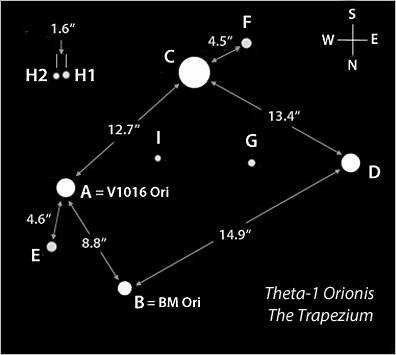Bob also suggests that the black spots close to the Trapezium may be proto-planetary discs, which are rotating discs of dense gas and dust surrounding a young newly formed star.
Monday, 12 October 2020
The Orion Trapezium Revisited
To produce my recent Orion image I took some shots at only 1 and 5 seconds so that I might preserve some detail in the Trapezium stars of the core. I was pleased to see that I managed to capture the four largest core stars with some separation.
But Bob Stuart processed these stars even further to bring out more nebulosity and dust clouds and spotted that the A and C stars in the core (see diagram) had slight bulges on them. My DSLR and lenses couldn't resolve any better detail than this, but Bob believes them to be the much smaller E and F stars in the cluster (see diagram below), but I'm not sure.
Bob also suggests that the black spots close to the Trapezium may be proto-planetary discs, which are rotating discs of dense gas and dust surrounding a young newly formed star.
Bob also suggests that the black spots close to the Trapezium may be proto-planetary discs, which are rotating discs of dense gas and dust surrounding a young newly formed star.
Subscribe to:
Post Comments (Atom)





No comments:
Post a Comment